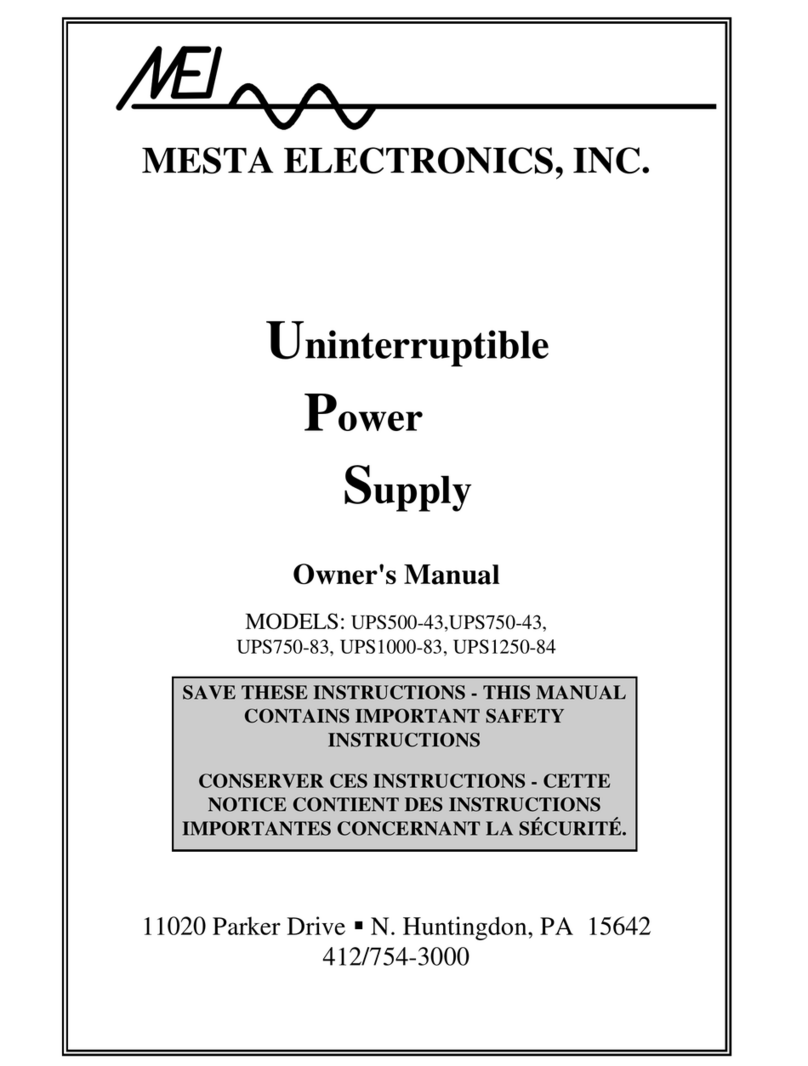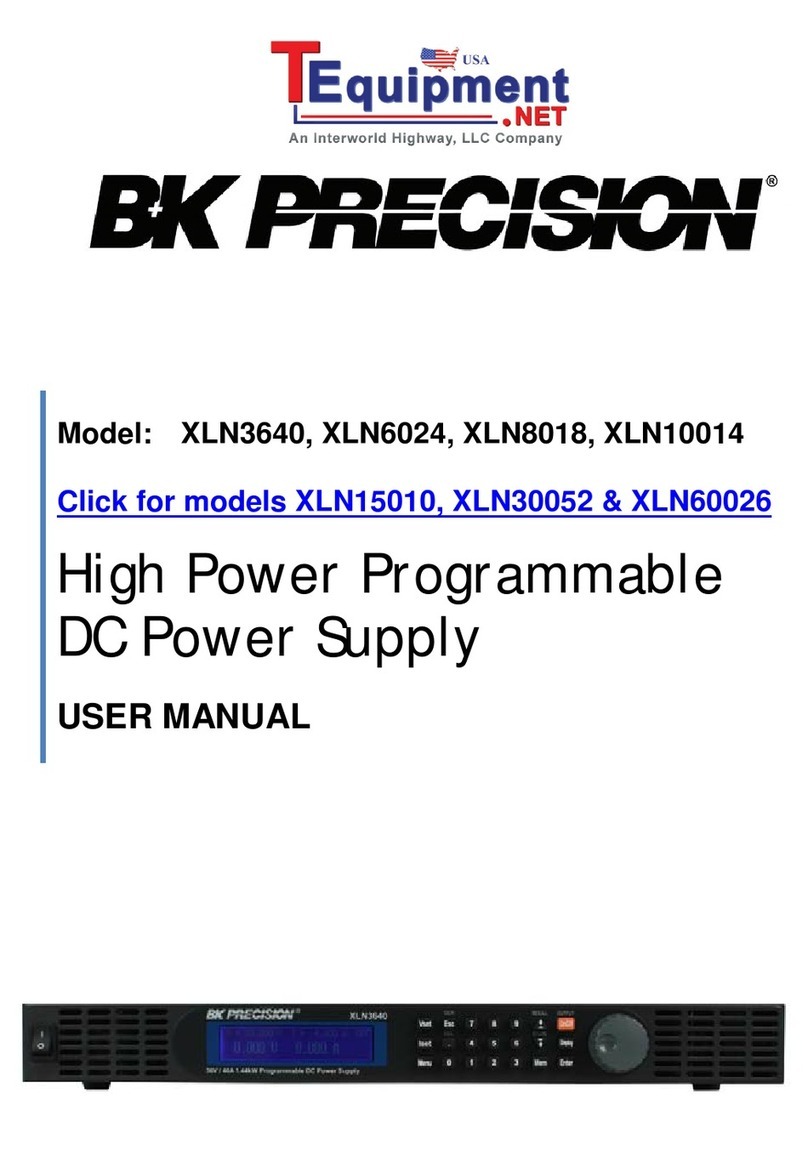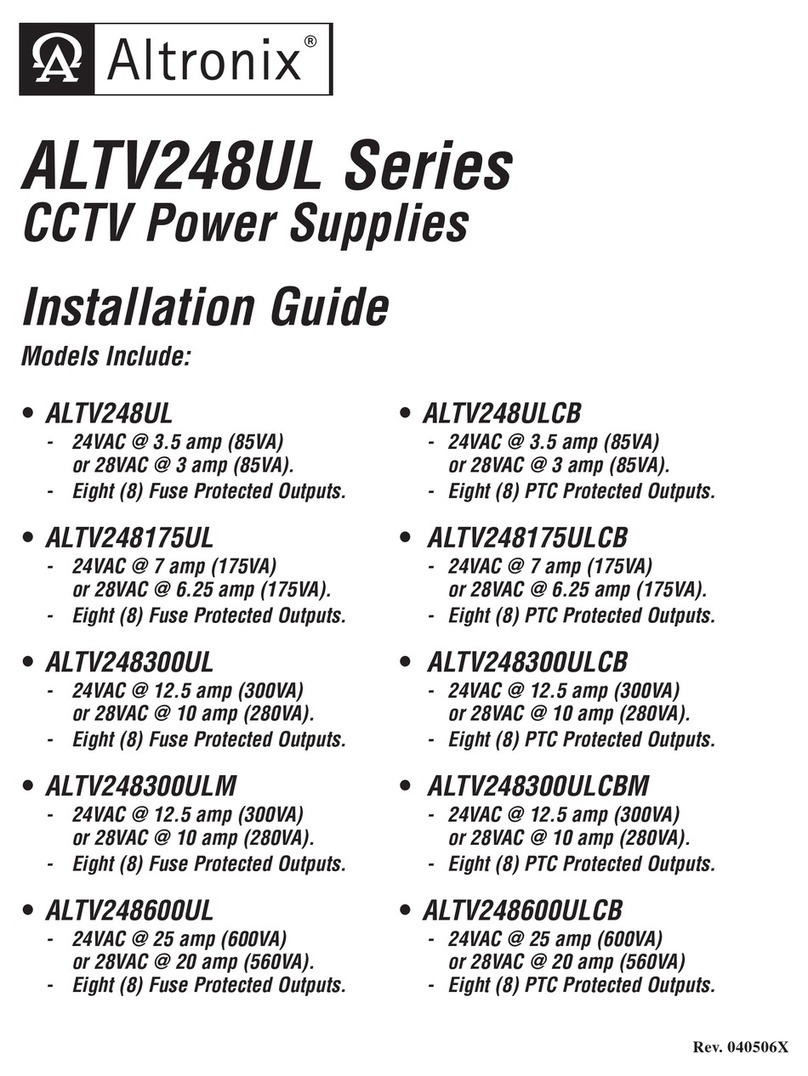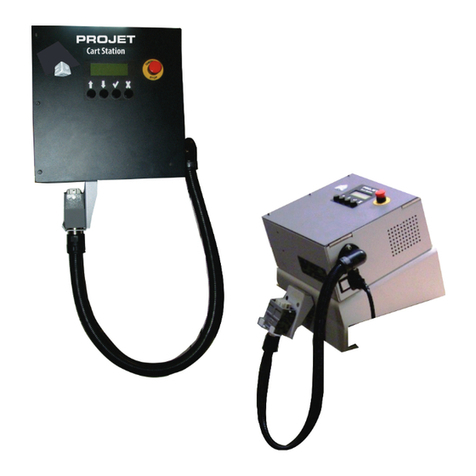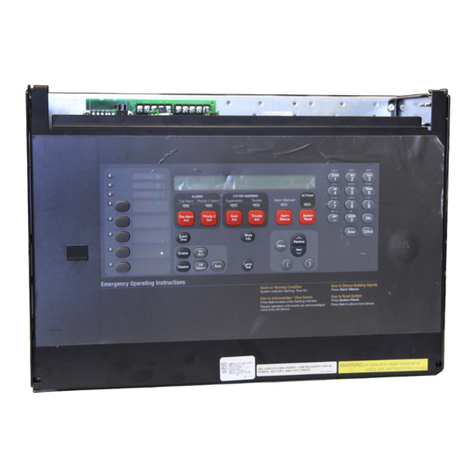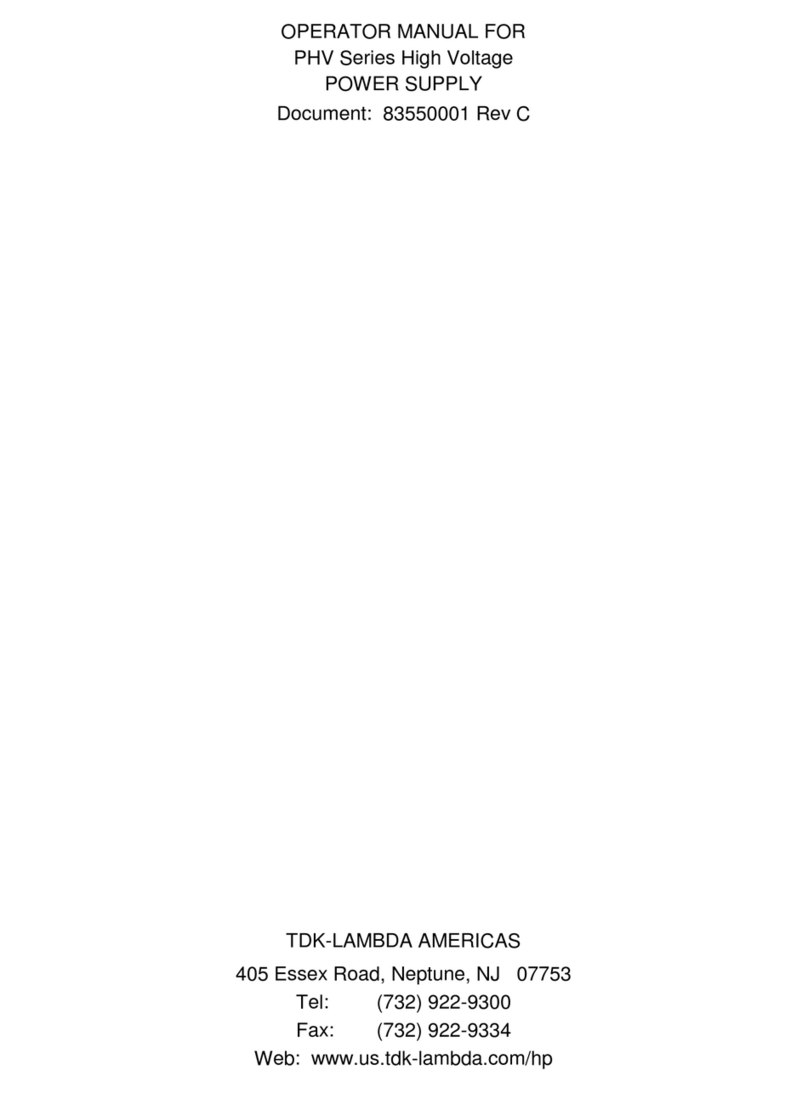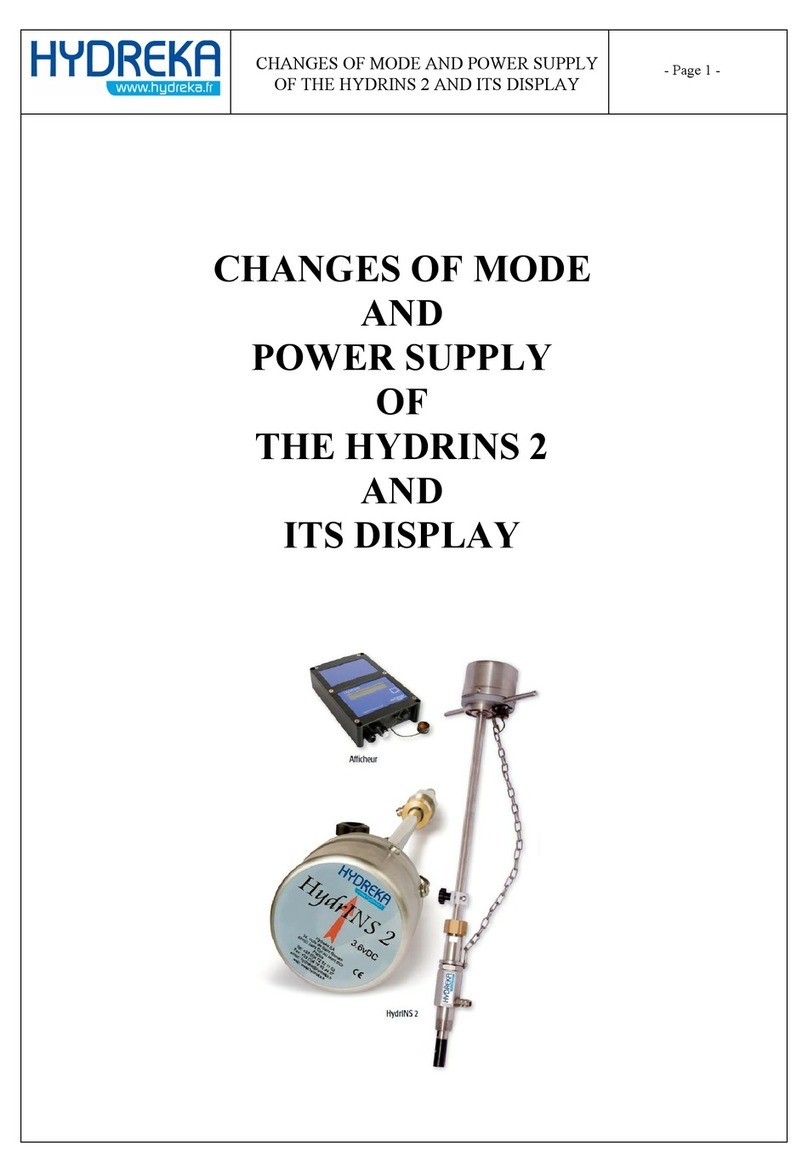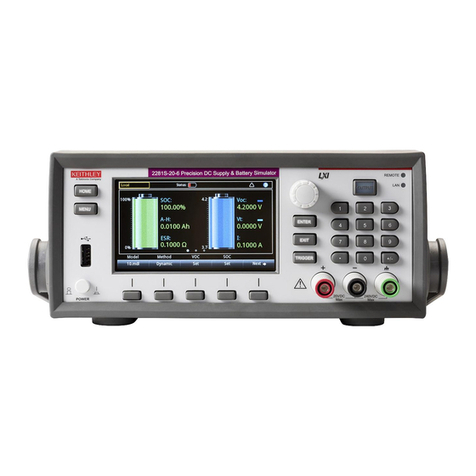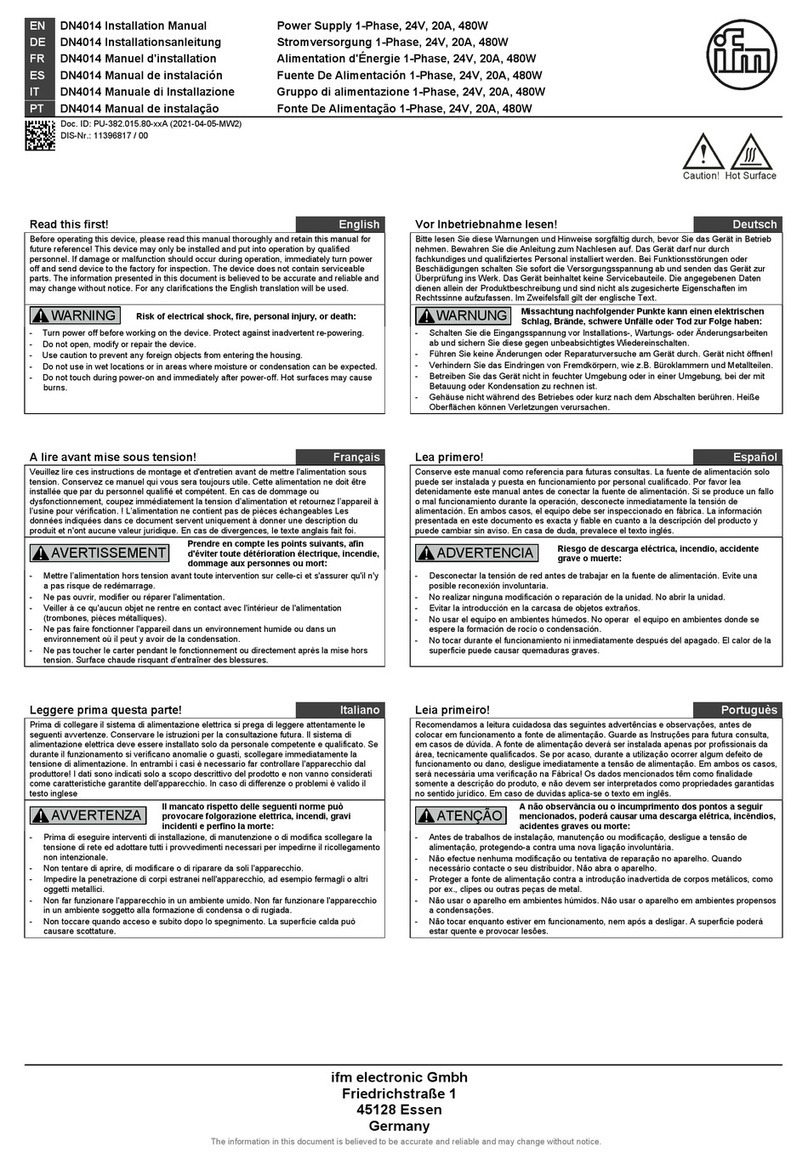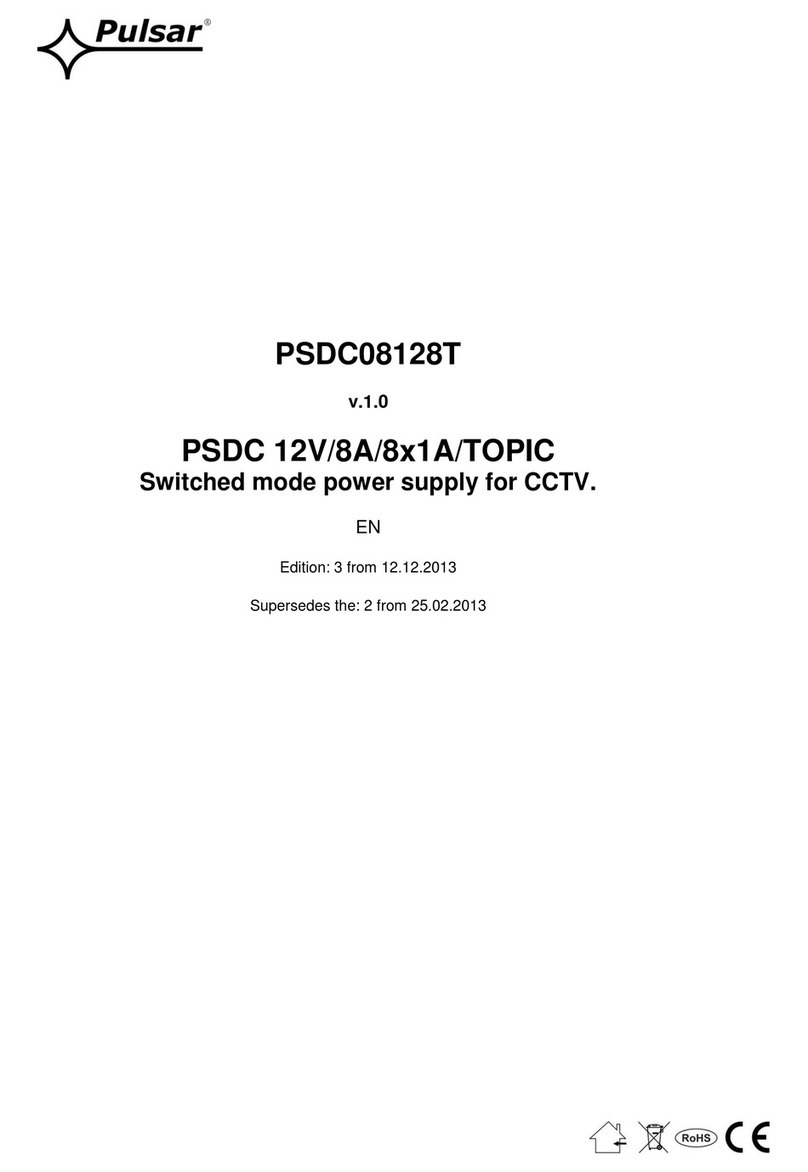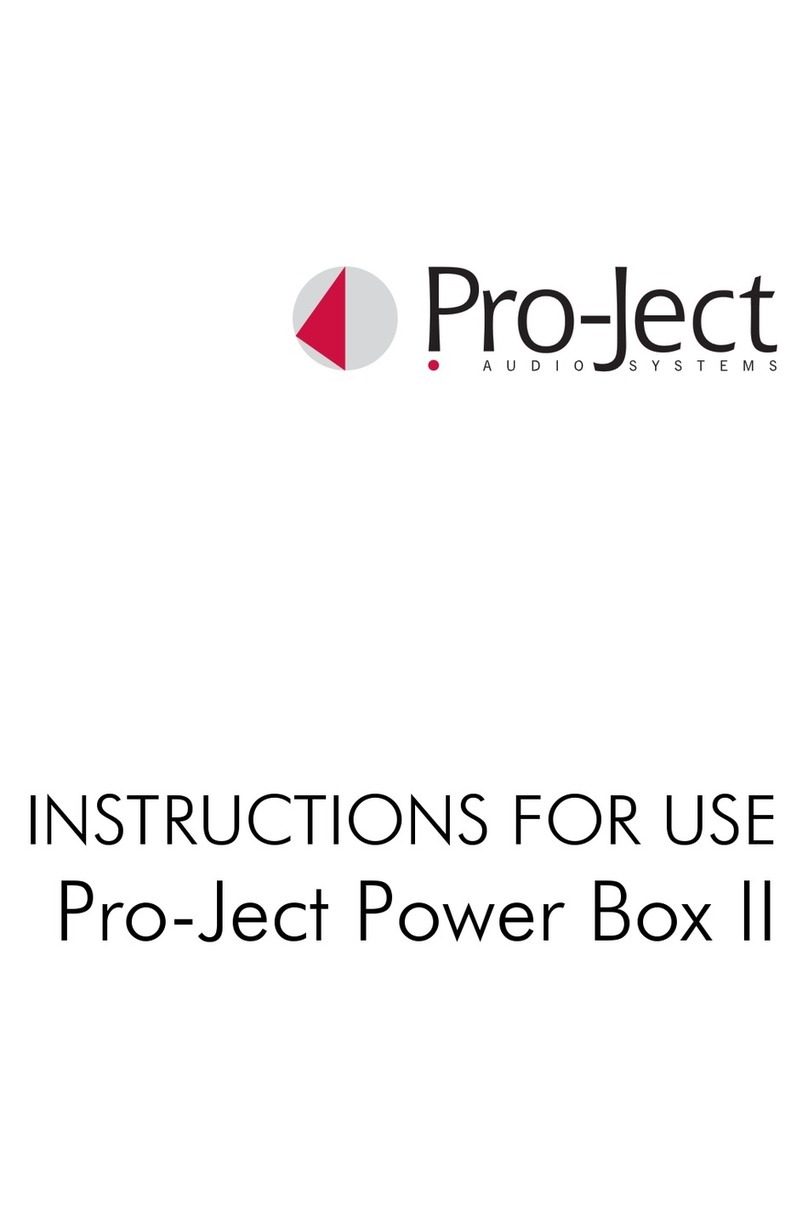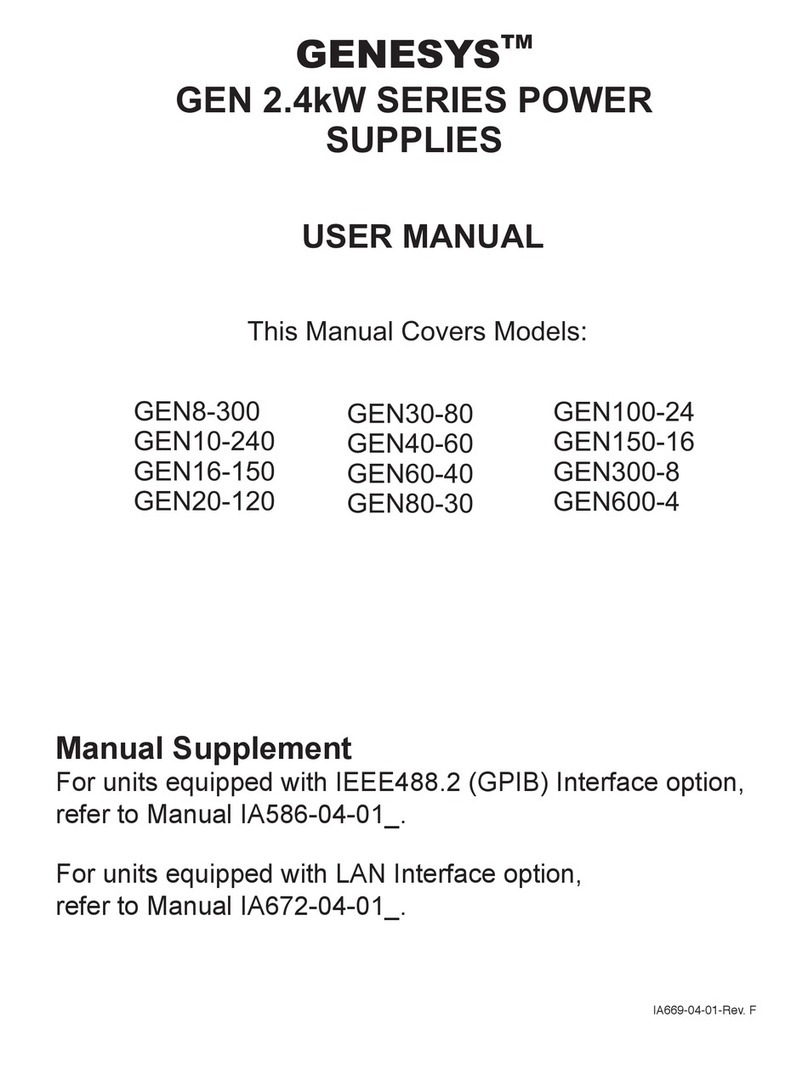MESTA UPS3000 User manual

MESTA ELECTRONICS, INC.
Uninterruptible
Power
Supply
Owner's Manual
MODELS: UPS3000, UPS3500, UPS5000
11020 Parker Drive N. Huntingdon, PA 15642
412/754-3000
SAVE THESE IMPORTANT
SAFETY INSTRUCTIONS

Models: UPS3000 - UPS5000
i
Table of Contents
1. INTRODUCTION....................................................................................................................1
2. GENERAL DESCRIPTION.....................................................................................................2
3. INSTALLATION......................................................................................................................4
4. OPERATING PROCEDURE...................................................................................................7
5. RS232 INTERFACE...............................................................................................................8
6. STORAGE............................................................................................................................11
7. INTERNAL MAINTENANCE.................................................................................................12
8. BATTERY INFORMATION...................................................................................................13
9. TROUBLESHOOTING .........................................................................................................16
APPENDIX A. UPS SPECIFICATIONS BY MODEL................................................................17
APPENDIX B. OPERATING PROCEDURE FOR OPTION A ..................................................21
APPENDIX C. DRY CONTACT STATUS RELAYS OPTION A................................................22
APPENDIX D. WARRANTY/SERVICE AND REPAIR..............................................................23
List of Illustrations
Figure 1: UPS Battery Tray Configuration................................................................................15
List of Tables
Table 1: UPS Software Parameters ...........................................................................................9
Table 2: RS232 Technical Specification Summary ..................................................................10
Table 3: RS232 9-Pin D-Connector Pinout...............................................................................10

Models: UPS3000 - UPS5000
ii
(Page Intentionally Left Blank)

1
1. INTRODUCTION
Thank you for buying the Mesta Electronics UPS! You are now an owner of a TRULY
UNINTERRUPTIBLE POWER SUPPLY. No other system on the market can match your UPS.
SAVE THESE INSTRUCTIONS - This manual contains important instructions that should be followed
during installation and maintenance of the UPS and its batteries. Please read this manual thoroughly
before installation and operation of your new unit.
WARNING - Your UPS contains nine 12 volt batteries wired in series providing a total nominal DC
voltage of 108 volts. This voltage is used to power the UPS when the AC utility is not available.
Because of the presence of this high voltage energy source, even when the power cord is not plugged
in, certain precautions must be taken to avoid possible injury should you need to unlock and enter your
unit. Before attempting to unlock or enter your unit, read the sections of this manual on "Internal
Maintenance" and "Battery Information" for important safety precautions.
WARNING - Always store the keys that unlock the unit in a safe place. DO NOT keep the keys in the
lock of the unit where someone unqualified or unsupervised may inadvertently open the unit.

2
2. GENERAL DESCRIPTION
As computers become increasingly fundamental to today's businesses, protection against power
disruptions has never been more critical; and since vital data and hardware are threatened by routine
sags, surges, spikes, and transients -- as well as major blackouts -- protection must be constant and
instantaneous.
The Mesta UPS system provides this kind of comprehensive protection by maintaining a clean, well-
regulated flow of power to critical loads, regardless of the quality of incoming AC line power. It remains
in a constant state of readiness, so there is no time delay in compensating for AC line failures.
Unlike many competitive units, the Mesta UPS system is truly uninterruptible. It remains in a
constant state of readiness, so there is no time delay in compensating for AC line failures. In contrast,
other systems may exhibit delays of 4 to 10 milliseconds -- long enough to cause serious losses of
data or equipment.
Unique microcontroller intelligence plus state-of-the-art components and manufacturing procedures
yield outstanding capabilities in the Mesta UPS system. Using a proprietary pulse-width-modulation
technique, the microcontroller directs the system to produce a very low harmonic, high quality sine
wave output -- perfectly matched in phase and voltage to the AC power line. The result is a completely
seamless transfer of the load from the inverter to the utility and vice versa during a power disturbance
or outage.
This zero-transfer-time feature, combined with a high frequency switching and custom magnetics,
results in a high operating efficiency of at least 93 percent and a total harmonic distortion of less than
one percent.
Because the microcontroller continually monitors the load and the power line, the Mesta UPS system:
•Starts under load with no damage to itself or the load.
•Handles nonlinear loads -- loads which require users of other UPS systems to buy more
expensive, higher rated units than they would otherwise need.
•Provides current limiting and short-circuit protection. The UPS provides a 300% overload
current limit for a finite time, and a short circuit placed directly across the output will not
damage the UPS or the load, even if the power is coming directly from the AC line.
The Mesta UPS system also features:
•High Reliability thanks to the large scale integration and generous overrating of all power
components. Its modular design provides for quick and easy maintenance should it ever be
needed.
•A more compact footprint and lighter weight than ferroresonant UPS units, because of its
custom transformer and intelligent operation.
•Quiet operation 1KVA through 2KVA units produce only 35 dBs of audible noise, a level that
is virtually indistinguishable from ambient noise. (In contrast, most other similarly sized
UPS units are many times louder, generating from 45-75 dBs.)
Straightforward controls make the Mesta UPS easy to operate, and audible and visual signals provide
clear indication of system status. In the event of a power line outage, the system:
•Sounds an intermittent alarm after five seconds. (The five-second delay eliminates
nuisance alarms from minor fluctuations.)
•Supplies power at maximum load for 7 to 20 minutes, depending upon model. (See
specifications for your specific model.) These times will be longer at lesser loads or with
back-up from external batteries.

3
•Sounds a continuous 30-second alarm when the usable battery has declined to 10 percent
of its full capacity.
•Automatically goes into a state of inactivity once regulated output can no longer be
maintained, waiting for the return of AC line availability. During this state of inactivity the
logic will continue to look for the AC power to return in order to restore normal operation. If
no AC power returns, however, after 2 hours the entire system will shutdown.
Once the AC power returns, the system's microcontroller employs optimum charging techniques to
extend battery life while minimizing charging time. The microcontroller follows a unique algorithm by
which it regulates the charging process and enables a minimal recharging time.
YOUR INVESTMENT IN MESTA'S TRULY UNINTERRUPTIBLE POWER SUPPLY INSURES THE
VALUABLE POWER PROTECTION YOU NEED.

4
3. INSTALLATION
Unpacking: Before unpacking your unit, examine the shipping carton for damage. If there is any
obvious damage, report it immediately to the dealer or carrier. If no damage is found, unpack the unit
and inspect it for shipping damage. Again, in case of any damage, report it directly to the dealer or the
carrier.
Environment: The MESTA UPS is designed to be used in an environment with a temperature range of
0-40°C and relative humidity of 0-95%, without condensation. The site should not be excessively dusty
or dirty. Clearances should be provided to the front and back of the unit so as not to block air inlets
and outlets. Also, keep the top of the unit clear of objects. The unit should never be used to sit or
stand on.
Location of Unit: The UPS should be in close proximity to the protected equipment: the longer the AC
wire runs, the more voltage drop and more risk of noise getting back into the system there are.
Voltage/Power Rating: Make sure that the voltage and power rating match the available line voltage
and load requirements. This can be done by comparing the input and output information printed on the
rating plate of the UPS with your requirements.
Power Cord Plug-in: Having verified voltage and power ratings, you are now ready to plug the UPS
into the AC power. Your unit will either have a detachable power cord or one that is fixed to the UPS.
(If you have a detachable cord, it was shipped with the unit. Only use this cord with your UPS. Do not
substitute other cords in its place as their current ratings may not be sufficient for your UPS needs.
Plug the detachable cord into the UPS input receptacle.) Now plug the AC power cord into the utility
receptacle at your facility.
UPS Power On: Having plugged your UPS into the AC utility, you may now turn on your UPS using
the front panel power switch. After a few seconds delay, the UPS will begin operating. Initially (for a
very short period of time) all front panel lights will flash on simultaneously, and the audible alarm will
beep once. Then the UPS will "power up" with the "UPS" red front panel light on. If the AC power
utility is present and within tolerance of the UPS, the "AC LINE" green front panel light will also be on.
After and additional couple of seconds, the "UPS" red light should go off, and the "AC LINE" green light
should remain on, indicating that the UPS is able to derive power from the AC power utility.
Fault Checking: If the normal UPS Power On sequence does not occur for you, perform one of the
following alternative actions:
1) If the "UPS" red light comes on and remains solidly on (also eventually to be accompanied by
an audible beeping alarm), recheck your connections to the AC utility. (Also check to see if any
breakers or fuses in that particular circuit of your building or in the back of your UPS are open.)
If after rechecking no problem is found, and the UPS will not perform according to the proper
procedure described above, contact the factory for further assistance.
2) If the normal UPS Power On procedure is not observed, and the warning conditions described
in alternative #1 are also not observed, contact the factory for further assistance.
Connecting the Load: Assuming that normal operation was observed, you can now plug your loads
into the receptacles at the back of the UPS. If during this procedure the "OVERLOAD" red light comes
on or starts blinking along with an audible alarm, your load is too large for the UPS, and some must be
removed or the UPS will shut down.
Installation Complete: Assuming an overload doesn't occur prior to attaching and turning on all loads,
you have completed the installation procedure of your UPS. From here on there is no special powering
up or powering down sequence that needs to be followed for either your load equipment or the UPS.
This installation procedure is only necessary to insure that the UPS did not incur any internal shipping
damage and that your building's AC utility is getting to the UPS.

5
Computer Terminal Connections: It is also suggested, but not required, that you connect a terminal
or computer to the RS232 interface (see section of the manual pertaining to this interface). Through
this communications interface you can obtain additional useful data that is either very difficult to
determine or is not available from the front panel lights. One of these parameters is the load on the
UPS. The microcontroller will indicate the ampere and volt-ampere load on the UPS. From this
information you will be able to determine if additional loads may be added in the future. It is advisable
that the steady state load observed on the UPS be limited to a maximum of around 80 to 85% of the
full rating of the UPS under normal operating conditions. This should provide enough margin under
most operating conditions.
Procedure for Changing Input or Output Voltage of UPS:
WARNING
Only qualified technicians or supervised personnel should attempt to change the input or output
voltage of a UPS and only after the following instructions have been read and fully understood.
Also, all instructions and warnings of the "Internal Maintenance" section of this manual should
be read and fully understood.
If your UPS is capable of 208/240 input voltage, the voltage that the UPS is set up for is printed on a
sticker at the input plug. If you wish to change to the other voltage, Mesta has provided a procedure
for qualified personnel to make such a change using only a medium, flat blade screwdriver. Likewise,
if your UPS is capable of 208/224/240 output voltage, the voltage that the UPS is set up for is printed
on a sticker next to the output receptacle on the back of the unit. If you wish to change to a different
output voltage, a qualified person may also make such a change. Changing this output voltage will not
affect the 120 volt output receptacles. To change either the input or output voltage of your UPS, turn
off the unit, unplug all loads to the unit, and open up the UPS be following the instructions in the
"Internal Maintenance" section of this manual. Once the unit is open, you can alter the wiring to the
main power transformer as follows. DO NOT change any other wiring than what is indicated below:
1. To change the input voltage of a UPS NOT equipped with the voltage regulation option (-R),
move the wire marked "IN+" as follows: Move "IN+" to terminal #5 of the transformer for 208
volts and to terminal #6 of the transformer for 240 volts. Use a flat blade screwdriver to
accomplish this task.
2. To change the input voltage of a UPS equipped with the voltage regulation option (-R), move
the wires marked "K1A" and "K1B" as follows: For 208 volts in, move "K1A" to terminal #5 and
"K1B" to terminal #4; for 240 volts in, move "K1A" to terminal #6 and "K1B" to terminal #5. Use
a flat blade screwdriver to accomplish this task.
3. To change the output voltage of a UPS, move the wires marked "OUT+" and "OUT-" as follows:
For 208 volts out, move "OUT+" to terminal #11 and "OUT-" to terminal #8;
For 224 volts out, move "OUT+" to terminal #11 and "OUT-" to terminal #7;
For 240 volts out, move "OUT+" to terminal #12 and "OUT-" to terminal #7.
For 208 volts out, move "OUT+" to terminal #11 and "OUT-" to terminal #8;
Use a flat blade screwdriver to accomplish this task.

6
Alternate Voltage Stickers: Shipped with your unit are alternate voltage stickers to be used if you
change the input or output voltage of you UPS. If you change the input voltage, take the new input
voltage sticker and place it over the one at the input plug of the UPS. If you change the output voltage,
take the new output voltage sticker and place it over the one at the output receptacle at the back of the
UPS.
Initialization Procedure: After changing the voltage wiring as previously described, close the UPS
according to the instructions in the "Internal Maintenance" section of this manual. Now you need to
perform an initialization procedure to the UPS. To perform this procedure, plug in the power cord of
the UPS into the AC utility power and switch on the "BATT/INT" AND "AC" breakers at the back of the
UPS. Then, while holding the front panel "ALARM RESET" button pressed in, turn on the UPS front
panel power switch (continuing to hold the "ALARM RESET" button pressed in for at least 5 seconds.
then release). After a few seconds, the audible alarm will start beeping and the front panel lights will
indicate the status of the initialization procedure.
If the "AC LINE" light is on solid and the "UPS" is flashing (other two lights don't matter) the
initialization was successful. At this time press the "ALARM RESET" button once and release. The
front panel lights will now indicate the AC input voltage that the UPS is set up for as follows:
AC
UPS
BATT
OVLD
NOMINAL INPUT VOLTAGE
ON OR OFF
OFF
ON
ON
208V
ON OR OFF
ON
OFF
ON
240V
Verify that the AC input voltage setup is correct, then press the "ALARM RESET" button again and
release. The front panel lights will now indicate the output voltage that the UPS is set up for as follows:
AC UPS BATT OVLD NOMINAL OUPUT
VOLTAGE
FLASHING
OFF
ON
OFF
208V
FLASHING
ON
OFF
OFF
224V
FLASHING
ON
OFF
ON
240V
If after the initialization procedure, all lights are flashing in unison, the procedure was unsuccessful.
Turn off the front panel power switch and recheck the following items:
•UPS' AC plug is plugged into the utility
•"BATT/INT" and "AC" breakers at the back of the UPS are on
•All loads are disconnected from the UPS
Repeat the initialization procedure, making sure you hold the "ALARM RESET" button pressed in for at
least 5 seconds. If you encounter trouble again, contact the factory for additional assistance.
Procedure Check: If the initialization procedure is successful, turn off the UPS. After waiting for the
UPS to go off completely (all front panel lights will go off), turn on the AC breakers (and external
battery breaker if external battery cabinets are used) on the back of the UPS. Then turn on the UPS.
Now the UPS should function normally using the AC line. Checking your work concerning the output
voltage can be accomplished by two methods: connect a terminal to the RS232 port to verify that the
output voltage is what you want it to be, or use an RMS voltmeter capable of measuring 240 volts to
measure the voltage directly at the output receptacle of the UPS. After verifying the output voltage,
you may plug in your external loads to the UPS.

7
4. OPERATING PROCEDURE
SYSTEM TURN-ON (REFER TO APPENDIX C FOR OPTION A)
Once plugged in and turned on, the MESTA UPS will begin supplying power to the load. The green
"AC LINE" and "BATTERY" lights will be on. If the AC line fails, the red "UPS" light will come on, and
after 5 seconds an intermittent alarm will sound for 30 seconds. (This alarm may be silenced by
pressing the "ALARM RESET" button on the control panel.)
The following are the conditions that are indicated by the light and beeping sequences:
AC LINE ON (green) AC line within tolerance
BATTERY ON (green) Solid -- over 90% charge
Off -- discharged
Flashing 75% dutycycle -- 50-90% charge
Flashing 50% dutycycle -- 25-50% charge
Flashing 25% dutycycle -- 25-10% charge
Flashing 10% dutycycle -- 10-1% charge
At this point a solid tone can be heard for 30 seconds.
UPS ON (red) Solid, and after 5 second delay, 30 seconds of intermittent
beeping -- drawing power from battery.
Flashing with "OVERLOAD" on -- system shutdown due to
overload. UPS needs attention.
Flashing with "BATTERY" off -- system shutdown due to drained
batteries. UPS needs attention.
OVERLOAD (red) Solid and solid tone -- greater than 150% overload.
Flashing and beeping -- 100-150% overload.
ALARM RESET button tests lights and alarms as well as silences alarm, except in case of an overload.
It is also used to test the batteries.
To Test the Batteries: The UPS is programmed to test the internal batteries automatically and under
load. The procedure for starting this 60 second test is to hold the "ALARM RESET" button in for at
least 5 seconds. Release the button, then touch it again three more times in short succession. This
will signal the microcontroller to begin testing the batteries. The UPS will start beeping to signal that
the test is in progress. Test results will be indicated by the "BATTERY ON" light as indicated above.
To obtain more precise test results, use the software interface provided with the system.

8
5. RS232 INTERFACE
For sophisticated applications the Mesta UPS system provides an RS232 communications interface
which can link the microcontroller with a remote computer or terminal. This two-way link allows users
to 1) collect detailed information on power usage and other characteristics of the load to which the UPS
is connected and 2) remotely control the UPS or the load. (For example: a system can be developed
to alert the computer to automatically save data and shut itself down when the UPS battery power is
dwindling and no emergency generator is available.)
Any computer or terminal equipped with an RS232 serial port capable of a 1200 baud rate can be used
to communicate with the UPS. If a terminal is being used, one can begin sending commands to the
UPS as soon as a 3-wire hardware interface is in place. If a computer is being used, a
communications software package that allows the computer to act as a terminal must be executed on
the computer. Mesta provides this software on a 51/4" or 31/2" diskette. Once communication has
been established with the UPS, the UPS will provide a ">" prompt, which signals the operator to enter a
command.
Software Commands: UPS information may be examined using the following commands:
Sn Status command displays the present status of a parameter. To display the status of a
particular parameter, type Sn<cr>. "S" indicates the status command, "n" represents a
letter from A to L designating the parameter you desire to observe, and <cr> indicates a
carriage return (or enter key) which is used to terminate the command. Table 1 contains
the list of available parameters that may be examined. As an example, if the present AC
line voltage is to be examined, one would type SA followed by striking the <cr> key. One
can also just enter S<cr> with no parameter letter and obtain a status update of 11 of the
most useful parameters all at once.
Vn View command is similar to the Status command except the View command will continually
display the status of the selected parameter until one presses the escape key on the
computer or terminal keyboard. To continually view the status of a particular parameter,
type Vn<cr>. "V" indicates the View command, "n" represents a letter from A to L
designating the parameter to be viewed, and <cr> indicates a carriage return (or enter key)
which is used to terminate the command. Again, Table 1 contains the list of available
parameters that may be examined. As an example, if the AC line voltage is to be viewed
continuously, one would type VA followed by striking the <cr> key. One can also just enter
V<cr> with no parameter letter and continually view the status of 11 of the most useful
parameters all at once.
<Esc> The escape key can be pressed at any time to abort any command. After pressing the
escape key, the UPS will display <Esc> to indicate such a key was pressed followed by a
new ">" prompt. At such a time a new command can be entered.

9
Table 1: UPS Software Parameters
Letter to Use
UPS Parameter
Notes
A
AC line voltages (in RMS volts)
B
UPS output voltage (in RMS volts)
C
Battery voltage (in DC volts)
D
AC line frequency (in Hertz)
E
UPS output frequency (in Hertz)
F
Battery charge remaining (percent)
1
G
UPS mode
H
UPS output current (in RMS amperes)
I
Current draw from battery (in DC amperes)
2
J
Fault status
K
UPS volt-amp output (in volt-amperes)
L
Temperature (in
°
C/F)
M
Inverter DC voltage (DC volts)
N
AC line amps (in RMS amps -- not true RMS)
O
V-Amp rating
P
Version
None
Parameters A through L displayed all at once
Notes on the MESTA UPS Parameters:
1. The accuracy of the percentage of battery charge remaining depends on operating conditions
and the present loading of the UPS. The accuracy will be much more precise at the lower
percentages than it is at the higher percentages (where the performance curve flattens and a
perfectly correct interpolation is more difficult - in the 92-100% range).
2. Current draw from the batteries is "+" if batteries are being discharged and "-" if batteries are
being charged. A small positive or negative value of .1 or .2 amps may not necessarily reflect
that the batteries are being charged or discharged.
Changing the Programmable Parameters (FSET): To set the three parameters of 1)minimum output
voltage, 2) frequency range allowed, and 3) slew rate (how fast you allow the output to change
frequency), all of which are in the non-volatile memory, the incoming AC line must first be disabled. To
accomplish this:
•Type ACDIS <rtn> to disable the incoming AC. The UPS will operate from the batteries when
you do this.
•Then type FSET <rtn> to enter the function set routine, and the first of the three programmable
function will appear on the screen with the question of whether you'd like to change this
particular parameter.
•As you respond by typing a Y(yes) or N (no), the screen will then indicate the value range
within which you can program the function.
•After programming the appropriate response for all three functions, the microcontroller will
return a prompt. When the prompt appears, simply type ACEN <rtn> to enable the UPS to
reconnect the utility's AC voltage. Don't forget this last step!

10
Table 2: RS232 Technical Specification Summary
CONNECTOR: 9 pin D female
FORMAT: ASCII, 1 start bit(0), 8 data bits, 1 stop bit(1)
BAUD RATE: 1200
PARITY: none
DUPLEX: full
PROTOCOL: None used. Interface is simple 3 wire (RXDATA, TXDATA, and GND) with no
hardware or software handshaking.
Table 3: RS232 9-Pin D-Connector Pinout
PIN 2: Transmit Data
PIN 3: Receive Date
PIN 5: Signal Ground
NOTE: UPS UNITS EQUIPPED WITH OPTION A HAVE DRY STATUS CONTACTS TO INDICATE
LOSS OF AC LINE AND LOW BATTERY. SEE APPENDIX C FOR DETAILED INFORMATION.

11
6. STORAGE
Battery Life: The MESTA UPS should be stored with the batteries fully charged. MESTA Battery
Packs should also be stored with the batteries fully charged. Storage temperature should be
maintained between -20°C and 40°C. The life of the batteries may be greatly reduced if stored at
temperatures exceeding 30°C for extended periods of time. Optimal storage temperature for maximum
battery life is 20°C or lower.
Power Switch: Make sure the power switch to the UPS is off prior to storing the UPS. Also, batteries
may be permanently damaged if not removed from storage periodically and fully recharged at least
once every 6 months. To recharge batteries inside UPS, simply remove the UPS from storage and
connect the unit to an AC power source for a minimum of 4 hours (make sure batteries are being
charged by monitoring the LEDs on the front panel of the UPS -- it should be off). Then you may turn
the unit off again and return it to storage for up to another 6 months. To recharge batteries in a battery
pack purchased from Mesta, follow the directions to connect the battery cabinet to a Mesta UPS in the
"Battery Information" section of this manual. Allow a minimum of 4 hours charging per battery
cabinet.

12
7. INTERNAL MAINTENANCE
WARNING
Only qualified technicians or supervised personnel should open the UPS and only after ALL of
the following WARNINGS and instructions are read and fully understood.
Mesta's UPS has been designed to provide unprecedented reliability; therefore it requires little or no
maintenance. However, should internal maintenance be required, please adhere to the following
warnings and instructions.
WARNING
Risk of Electric Shock exists inside the UPS. The UPS receives power from the AC source
(via the AC power cord) and a DC source (via the internal batteries). Maintenance personnel
must be aware of this hazard, or they may be exposed to an electrical shock hazard that could
result in death or injury or damage to the UPS or its electrical loads.
WARNING
The UPS internally contains capacitive components which remain energized even after power to
the UPS has been turned off. A unit's front panel LEDs are functioning normally such that when
the unit is turned on, one or more of the LEDs lights up steadily or periodically, and when the
unit is then turned off, all LEDs go off within 20 seconds. Under these circumstances the
voltage across these capacitive components will be minimized to safe levels within 1 minute of
turning the UPS off. If, however, the LEDs never come on or never go off during operating of
the Transfer Switch, a problem exists with the unit. Under such conditions it is possible for
hazardous voltages to remain for longer periods of time. If such a malfunction exists, it is
advisable not to open the unit. Instead, contact the manufacturer or nearest repair center. A
qualified technician will need to check the DC voltage across the buss bars that connect the
large capacitors attached to the heat sink before proceeding with any internal maintenance.
This voltage could be as high as 250 volts DC. One should wait until voltage is below 30 volts
DC before proceeding. Otherwise, maintenance personnel may be exposed to an electrical
shock hazard that could result in death or injury, or damage to the UPS or its electrical loads
may occur.
Instructions for Opening and Closing the UPS: Before opening the unit from the front using its keys,
make sure the UPS power switch is "OFF" and the AC power cord is unplugged. After all front panel
LEDs go off, turn off all breakers on the back of the UPS. Only open unit from the front using the key.
Turn key clockwise 1/4 turn and open front door. If desired, the top of the unit can also be removed for
access. DO NOT try to enter the unit any other way (such as removing screws from back of unit) as
such an action may result in risk of Electric Shock. If extensive work is to be done within the UPS,
remove the battery trays from the unit as described in the "Battery Information" section of this
manual. When completed servicing inside of unit, close door, and lock unit by turning key
counterclockwise 1/4 turn. Turn on all breakers (except the external battery breaker if an external
battery cabinet is not being used) on the back of the UPS.

13
8. BATTERY INFORMATION
The standard batteries supplied in the MESTA UPS are eighteen sealed lead-acid maintenance-free 12
volt 15 amp-hour batteries. These batteries are wired in series to provide a total nominal voltage of
108 volts DC. Expected battery float life is 5 years at room temperature (70°F), although frequent
discharges and high ambient temperatures will shorten battery life. The standard battery supplied is
designed to be kept at a constant 13.5 to 13.8 volts. The microprocessor is set to charge the batteries
to 13.7 volts. It will recharge the fully discharged batteries in approximately 2 hours. The run time that
one can expect is dependent on the magnitude of the load and the age and state of charge of the
batteries.
WARNING
Only qualified technicians or supervised personnel should remove and/or replace the batteries.
Batteries have a high short-
circuit capacity: MISTAKES IN CONNECTING OR
DISCONNECTING CAN CAUSE CONNECTIONS TO ARC OR WELD AND COULD RESULT IN
SEVERE BURNS. DO NOT TOUCH UNINSULATED BATTERY TERMINALS. Otherwise,
maintenance personnel may be exposed to an electrical shock hazard that could result in death
or injury or damage to the UPS or its electrical loads.
Adding Battery Packs to Your UPS: Additional battery packs may be added to your UPS to extend
the battery time provided by the internal batteries of your UPS (consult the specifications portion of this
manual to determine maximum capacity that can be added to your particular UPS). It is recommended
that only battery packs and cabling supplied by Mesta Electronics be added so that complete
compatibility with your UPS can be guaranteed. Different manufacturer's battery packs may possibly
used, but their use should be cleared with Mesta before doing so. Only qualified technicians should
attempt connecting a battery pack other than the Mesta BP9-15 to your UPS. CAUTION - not clearing
other battery packs with Mesta may result in serious damage to the UPS and/or the battery pack.
Mesta Battery Pack model number BP9-15 is custom designed to mate with all UPS models covered
by this manual. The BP9-15 comes with all power cabling necessary to mate with the UPS. The BP9-
15 is made to fit under the UPS (a maximum of ONE battery pack is allowed beneath a UPS). Should
there be more than one extra battery pack, the battery pack units can be stacked one above the other
next to the UPS (a maximum of THREE battery packs may be stacked in this fashion).
To connect one or more BP9-15 battery packs to a UPS perform the following steps:
1. Verify that the breaker on the back of each battery pack is turned off. Also, verify that the UPS
is off and unplugged from the AC power. If battery packs are already installed with the UPS,
make sure the breaker on each of these packs is off as well.
2. Locate the battery packs in the position that has been chosen, either under or to the side of the
UPS.
3. Remove battery terminal protective covers from the back of the UPS and the back of the battery
pack using a screwdriver.
4. Using a hammer, remove knockouts from protective covers. The knockouts to be removed
depend on the location of the battery packs. For the most frequent arrangement, where the
UPS is located on top of a single cabinet, remove the knockout at the top of the battery pack
protective cover and at the bottom of the UPS protective cover. Contact factory for alternative
arrangements.
5. Insert a "Thomas & Betts" part #3303M (or equivalent) strain relief into all knockout holes.
6. Insert one end of the battery cable supplied with the battery pack through the strain relief in the
battery pack terminal cover.

14
7. Remove "+", "-" and "GND" terminal screws from the the battery pack. Connect the wires of the
inserted end of the cable as follows: White wire to "+" terminal, black wire to "-" terminal, and
green wire to "GND" screw. Replace screws and tighten to 40 lb-in.
8. Replace the battery pack terminal cover onto the battery pack and secure with screws.
9. Insert other end of the battery cable through the strain relief in the UPS terminal cover.
10. Remove "+", "-" and "GND" terminal screws from the the UPS. Connect the wires of the cable
as follows: White wire to "+" terminal, black wire to "-" terminal, and green wire to "GND" screw.
Replace screws and tighten to 40 lb-in.
11. Replace the battery pack terminal cover onto the UPS and secure with screws. Tighten the
strain relief screws to securely hold the battery cable.
12. Turn on all breakers on the back of the UPS. Turn on the breaker on the back of each battery
pack. Immediately consult factory if breakers trip off while attempting this.
13. Plug UPS into the AC power source. At this time you are ready to turn the UPS on.
WARNING
Risk of Electric Shock – make sure external battery terminals on UPS and all battery packs are
covered by protective covers at all times. Also, if battery packs are to be subsequently removed
from the system, all exposed knockout holes must be covered by a suitable knockout plug.
Instruction for Removing UPS Battery Tray:
WARNING
Only qualified technicians or supervised personnel should remove and/or replace the batteries.
Batteries have a high short-circuit c
apacity: MISTAKES IN CONNECTING OR
DISCONNECTING CAN CAUSE CONNECTIONS TO ARC OR WELD AND COULD RESULT IN
SEVERE BURNS. DO NOT TOUCH UNINSULATED BATTERY TERMINALS. Otherwise,
maintenance personnel may be exposed to an electrical shock hazard that could result in death
or injury or damage to the UPS or its electrical loads.
Mesta has designed this unit to provide maximum battery reliability, thus requiring little or no
maintenance. However, should a battery problem be detected, please adhere to the following
instructions and preceding warnings. The unit has been designed to allow easy access and
replacement of the batteries by a qualified technician or supervised personnel.
Removing the battery tray necessitates opening the front door of the unit. Follow the procedure for
opening the UPS outlined in the "Internal Maintenance" section of this manual. The following
precautions should be observed while working on batteries:
1) Remove watches, rings, or other metal objects.
2) Use tools with insulated handles.
3) Do not lay tools or metal parts on top of batteries.
4) Do not touch battery terminals to chassis (watch for inadvertent contact that can occur if not
being careful when removing lead wires to battery terminals).
After opening the front door of the UPS, unfasten the battery chassis by unscrewing the screw on the
right side of the battery tray. Slide the tray out approximately 6 inches. Remove the black wire marked
"B-" from the front left battery. Slide the battery tray out far enough to access the white wire marked
"B+" attached to the rear right battery. Continue sliding the tray completely out of the unit. Do not slide
the tray along the floor or other surface, as doing so may damage the battery holding straps. The tray
must be carried or rolled on rollers and not slid whenever possible. (Round wooded dowels or spare
screwdrivers may be used as rollers.

15
After the battery tray is removed from the cabinet, individual batteries may be disconnected and
replaced, or the entire tray of batteries may be replaced. Exercise extreme caution to insure that
batteries are replaced correctly, insuring proper battery polarities (consult figure 1 for correct wiring).
Batteries must be secured back onto the tray using methods similar to the strapping and fasteners
originally supplied.
To reinsert battery tray back in UPS, first make sure the ends of the "B+" and "B-" I{S wires are
accessible. Line up the tray as shown in figure 1 (being careful to note the position of the tray
mounting hole, "+" and "=" battery terminals). Align the tray with the internal UPS battery slides. Lift
the back of the tray (you may use the back most battery strap to lift the tray if you wish) and set the
back of the tray in the internal battery slides. Attach the white "B+" wire to the "+" terminal of the rear
right battery. Lift the front of the battery tray and gently push it into the UPS, insuring that the tray is
within the slides of the UPS. Reattach the "B-" wire to the "-" terminal of the front left battery before the
tray is fully pushed in. Then push the tray in completely until the tray mounting hole lines up with the
hole on the right slide of the UPS. Thread the screw into the slide and tighten.
Figure 1: UPS Battery Tray Configuration
Tray fits
within slides
"B+" wire
connects here
Back of tray
Rear right battery
Tray mounting hole
"B-"wire
connects here
Front left battery
Front of tray

16
9. TROUBLESHOOTING
In the case of a UPS shutdown check the status of the front panel lights before
attempting to restart the system. This information is critical in determining why the
UPS shut down.
1. Check and record the status of each of the four front panel lights. (on, off, flashing)
2. If the OVERLOAD light is on and the UPS ON light is flashing the system shut down due to an
overload.
3 If all four front panel lights are flashing the system has gone into a diagnostic mode.
4. If the system is in a diagnostic mode press and hold the reset button and record the status of
the four front panel lights. (on, off, flashing)
5. If the system is in a diagnostic you may also check the fault status indication through the
RS232 communications interface.
6. At this point it is recommended that you contact a Mesta representative for assistance.

17
APPENDIX A. UPS SPECIFICATIONS BY MODEL
This section of the Mesta Electronics Owner's Manual contains the full set of operating specifications
for each of the models covered herein.
UPS Models
UPS3000 •3.0KVA/KW
UPS3500 •3.5KVA/KW
UPS5000 •5.0KVA/KW
This manual suits for next models
2
Table of contents
Other MESTA Power Supply manuals
